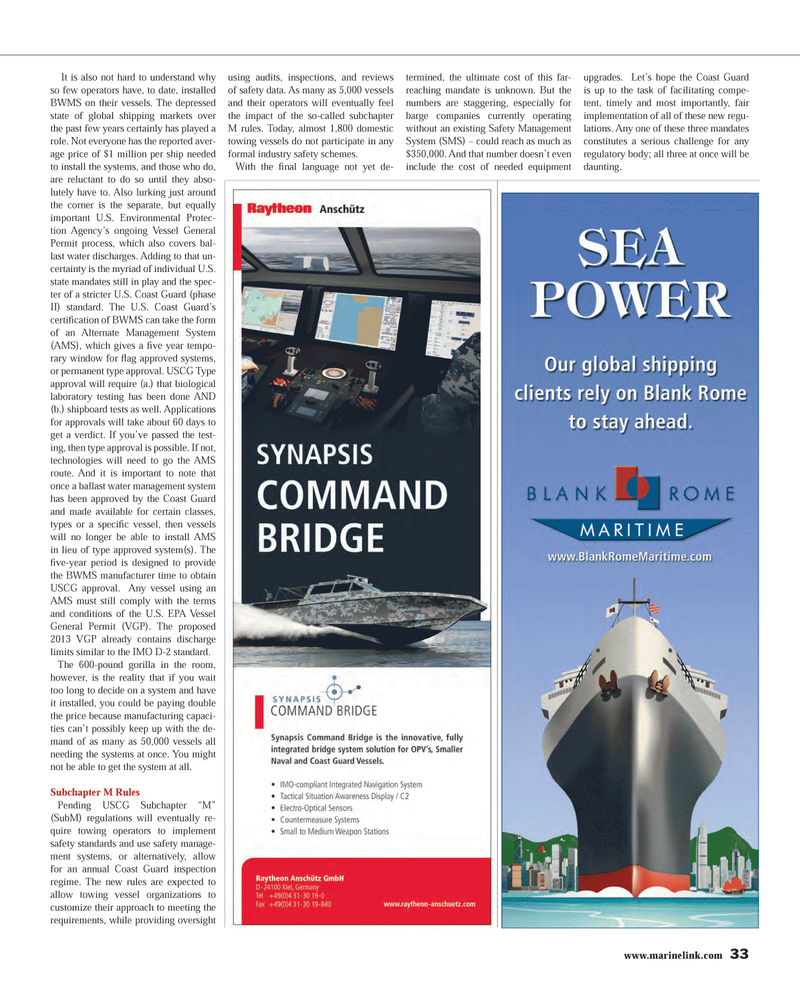
Page 33: of Maritime Reporter Magazine (March 2013)
U.S. Coast Guard Annual
Read this page in Pdf, Flash or Html5 edition of March 2013 Maritime Reporter Magazine
www.marinelink.com 33 It is also not hard to understand why so few operators have, to date, installed BWMS on their vessels. The depressed state of global shipping markets over the past few years certainly has played a role. Not everyone has the reported aver- age price of $1 million per ship needed to install the systems, and those who do, are reluctant to do so until they abso-lutely have to. Also lurking just around the corner is the separate, but equally important U.S. Environmental Protec-tion Agency?s ongoing Vessel General Permit process, which also covers bal-last water discharges. Adding to that un- certainty is the myriad of individual U.S. state mandates still in play and the spec-ter of a stricter U.S. Coast Guard (phase II) standard. The U.S. Coast Guard?s certiÞ cation of BWMS can take the form of an Alternate Management System (AMS), which gives a Þ ve year tempo- rary window for ß ag approved systems, or permanent type approval. USCG Type approval will require (a.) that biological laboratory testing has been done AND (b.) shipboard tests as well. Applications for approvals will take about 60 days to get a verdict. If you?ve passed the test-ing, then type approval is possible. If not, technologies will need to go the AMS route. And it is important to note that once a ballast water management system has been approved by the Coast Guard and made available for certain classes, types or a speciÞ c vessel, then vessels will no longer be able to install AMS in lieu of type approved system(s). The Þ ve-year period is designed to provide the BWMS manufacturer time to obtain USCG approval. Any vessel using an AMS must still comply with the terms and conditions of the U.S. EPA Vessel General Permit (VGP). The proposed 2013 VGP already contains discharge limits similar to the IMO D-2 standard.The 600-pound gorilla in the room, however, is the reality that if you wait too long to decide on a system and have it installed, you could be paying double the price because manufacturing capaci-ties can?t possibly keep up with the de- mand of as many as 50,000 vessels all needing the systems at once. You might not be able to get the system at all. Subchapter M Rules Pending USCG Subchapter ?M? (SubM) regulations will eventually re-quire towing operators to implement safety standards and use safety manage-ment systems, or alternatively, allow for an annual Coast Guard inspection regime. The new rules are expected to allow towing vessel organizations to customize their approach to meeting the requirements, while providing oversight using audits, inspections, and reviews of safety data. As many as 5,000 vessels and their operators will eventually feel the impact of the so-called subchapter M rules. Today, almost 1,800 domestic towing vessels do not participate in any formal industry safety schemes.With the Þ nal language not yet de- termined, the ultimate cost of this far- reaching mandate is unknown. But the numbers are staggering, especially for barge companies currently operating without an existing Safety Management System (SMS) ? could reach as much as $350,000. And that number doesn?t even include the cost of needed equipment upgrades. Let?s hope the Coast Guard is up to the task of facilitating compe-tent, timely and most importantly, fair implementation of all of these new regu-lations. Any one of these three mandates constitutes a serious challenge for any regulatory body; all three at once will be daunting. MR #3 (26-33).indd 33MR #3 (26-33).indd 333/4/2013 5:06:46 PM3/4/2013 5:06:46 PM

 32
32

 34
34
